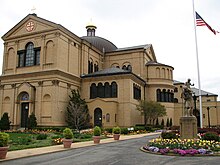Aristide Leonori


Aristide Leonori (28 July 1856 – 30 July 1928) was an Italian architect and engineer.
Biography
Born in Rome to Rafael Leonori and Anna Ianari, he entered the Roman College at the age of 8, and in 1875, at the age of nineteen, he graduated with a degree in civil engineering. He mainly worked in building churches and religious structures. Among these, he designed the chapel of Our Lady of the Sacred Heart in the famed Sant'Andrea della Valle in Rome.
In Rome, Leonori designed at least five churches and several hospitals, including San Patrizio, the Irish National Church in Rome, completed in 1892, and Santa Croce in Via Flaminia in 1912 and the Basilica church of San Giuseppe al Trionfale in the Trionfale quartiere of Rome. One of his biggest projects was the design and construction of the Church of St. Joseph in Cairo, Egypt, built in 1909. He helped design the belltower for the Shrine of the Virgin of the Rosary of Pompei (1912) in Pompeii, Italy. In addition to designing The Franciscan Monastery of the Holy Land in Washington, D.C.,[1] Leonori contributed to several other magnificent churches in the United States: the Cathedral Basilica of St. Louis (1907); St. Joseph’s (New) Cathedral in Buffalo, New York (1912); and Holy Rosary Church in Washington, D.C. (1923).
Between 1898 and 1913, he published in Rome a twice-monthly magazine in Latin titled Vox Urbis: de litteris et bonis artibus commentarius. He died in Rome in 1928.
References
- Derived from Italian Wikipedia entry.
- Order of St. Francis website.
Notes
- ^ Photos of Franciscan Monastery in Washington, D.C. Archived February 1, 2014, at the Wayback Machine
